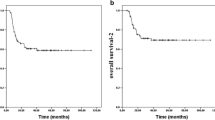Abstract
Tumor necrosis (TN) can lower responsiveness to chemotherapy and confer basic resistance to anti-cancer therapy. We investigated the association of TN with poor clinical features and outcome in diffuse large B cell lymphoma (DLBCL). We examined the presence or absence of TN in 476 DLBCL patients of who received rituximab, cyclophosphamide, doxorubicin, vincristine, and prednisone (R-CHOP) therapy. Eighty-nine (18.7 %) patients had TN at diagnosis. Patients with TN had a progression-free survival (PFS) and overall survival (OS) of 39.3 and 46.7 %, whereas patients without TN had a PFS and OS of 73.4 and 82.6 %. Adverse clinical factors of poor Eastern Cooperative Oncology Group performance status ≥ grade 2 (p = 0.005), elevated lactate dehydrogenase ratio >1 (p < 0.001), advanced Ann Arbor stage (p = 0.002), and bulky disease (p = 0.026) were more prevalent in the TN group than the non-TN group. Cox regression model analysis revealed TN as an independent prognostic factor for PFS and OS in DLBCL (PFS, hazard ratio [HR] = 1.967, 95 % confidence interval [CI] = 1.399–2.765, p < 0.001; OS, HR = 2.445, 95 % CI = 1.689–3.640, p < 0.001). The results indicate that TN could reflect adverse clinical features and worse prognosis in DLBCL patients receiving R-CHOP therapy.


Similar content being viewed by others
References
Menon MP, Pittaluga S, Jaffe ES (2012) The histological and biological spectrum of diffuse large B-cell lymphoma in the World Health Organization classification. Cancer J 18:411–420
Campo E, Swerdlow SH, Harris NL, Pileri S, Stein H, Jaffe ES (2011) The 2008 WHO classification of lymphoid neoplasms and beyond: evolving concepts and practical applications. Blood 117:5019–5032
Coiffier B, Lepage E, Briere J, Herbrecht R, Tilly H, Bouabdallah R et al (2002) CHOP chemotherapy plus rituximab compared with CHOP alone in elderly patients with diffuse large-B-cell lymphoma. N Engl J Med 346:235–242
Feugier P, Van Hoof A, Sebban C, Solal-Celigny P, Bouabdallah R, Fermé C et al (2005) Long-term results of the R-CHOP study in the treatment of elderly patients with diffuse large B-cell lymphoma: a study by the Groupe d’Etude des Lymphomes de l’Adulte. J Clin Oncol 23:4117–4126
Ziepert M, Hasenclever D, Kuhnt E, Glass B, Schmitz N, Pfreundschuh M et al (2010) Standard International prognostic index remains a valid predictor of outcome for patients with aggressive CD20+ B-cell lymphoma in the rituximab era. J Clin Oncol 28:2373–2380
Sehn LH, Berry B, Chhanabhai M, Fitzgerald C, Gill K, Hoskins P et al (2007) The revised International Prognostic Index (R-IPI) is a better predictor of outcome than the standard IPI for patients with diffuse large B-cell lymphoma treated with R-CHOP. Blood 109:1857–1861
Zhou Z, Sehn LH, Rademaker AW, Gordon LI, Lacasce AS, Crosby-Thompson A et al (2014) An enhanced International Prognostic Index (NCCN-IPI) for patients with diffuse large B-cell lymphoma treated in the rituximab era. Blood 123:837–842
Juweid ME, Stroobants S, Hoekstra OS, Mottaghy FM, Dietlein M, Guermazi A et al (2007) Use of positron emission tomography for response assessment of lymphoma: consensus of the imaging subcommittee of International Harmonization Project in Lymphoma. J Clin Oncol 25:571–578
Weiler-Sagie M, Bushelev O, Epelbaum R, Dann EJ, Haim N, Avivi I et al (2010) (18)F-FDG avidity in lymphoma readdressed: a study of 766 patients. J Nucl Med 51:25–30
Hopper KD, Diehl LF, Cole BA, Lynch JC, Meilstrup JW, McCauslin MA (1990) The significance of necrotic mediastinal lymph nodes on CT in patients with newly diagnosed Hodgkin disease. AJR Am J Roentgenol 155:267–270
Saito A, Takashima S, Takayama F, Kawakami S, Momose M, Matsushita T (2001) Spontaneous extensive necrosis in non-Hodgkin lymphoma: prevalence and clinical significance. J Comput Assist Tomogr 25:482–486
Adams HJ, de Klerk JM, Fijnheer R, Dubois SV, Nievelstein RA, Kwee TC (2015) Prognostic value of tumor necrosis at CT in diffuse large B-cell lymphoma. Eur J Radiol 84:372–377
Swinson DE, Jones JL, Richardson D, Cox G, Edwards JG, O’Byrne KJ (2002) Tumour necrosis is an independent prognostic marker in non-small cell lung cancer: correlation with biological variables. Lung Cancer 37:235–240
Kim SJ, Kim BS, Choi CW, Choi J, Kim I, Lee YH et al (2007) Ki-67 expression is predictive of prognosis in patients with stage I/II extranodal NK/T-cell lymphoma, nasal type. Ann Oncol 18:1382–1387
Boellaard R, O’Doherty MJ, Weber WA, Mottaghy FM, Lonsdale MN, Stroobants SG et al (2010) FDG PET and PET/CT: EANM procedure guidelines for tumour PET imaging: version 1.0. Eur J Nucl Med Mol Imaging 37:181–200
Avivi I, Zilberlicht A, Dann EJ, Leiba R, Faibish T, Rowe JM et al (2013) Strikingly high false positivity of surveillance FDG-PET/CT scanning among patients with diffuse large cell lymphoma in the rituximab era. Am J Hematol 88:400–405
An YS, Yoon JK, Lee SJ, Jeong SH, Lee HW. Clinical significance of post-treatment 18F-fluorodeoxyglucose uptake in cervical lymph nodes in patients with diffuse large B-cell lymphoma. Eur Radiol. 2016 [Epub ahead of print]
Brown JM (2007) Tumor hypoxia in cancer therapy. Methods Enzymol 435:297–321
Brown JM, Wilson WR (2004) Exploiting tumour hypoxia in cancer treatment. Nat Rev Cancer 4:437–447
Adams HJ, de Klerk JM, Fijnheer R, Heggelman BG, Dubois SV, Nievelstein RA et al (2016) Tumor necrosis at FDG-PET is an independent predictor of outcome in diffuse large B-cell lymphoma. Eur J Radiol 85:304–309
Acknowledgments
This study was supported by a grant from the National R&D Program for Cancer Control, Ministry for Health and Welfare, Republic of Korea (0920050).
Author information
Authors and Affiliations
Corresponding author
Ethics declarations
Approval for retrospective review of the records was obtained from the Institutional Review Boards of all participating medical centers.
Conflict of interest
The authors declare that they have no conflict of interest.
Rights and permissions
About this article
Cite this article
Song, MK., Chung, JS., Shin, DY. et al. Tumor necrosis could reflect advanced disease status in patients with diffuse large B cell lymphoma treated with R-CHOP therapy. Ann Hematol 96, 17–23 (2017). https://doi.org/10.1007/s00277-016-2822-8
Received:
Accepted:
Published:
Issue Date:
DOI: https://doi.org/10.1007/s00277-016-2822-8




